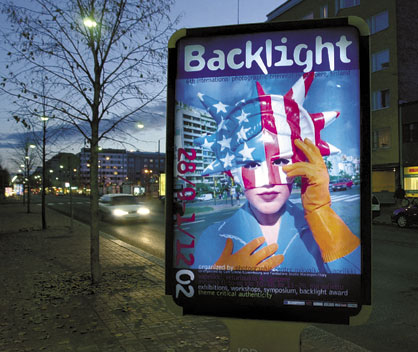There has been a photographic triennial every since the coherent review of British photography in 1987. Backlight is like a melting pot of different styles and approaches in global documentary photography. While the exhibitors of 1987 shared the same nationality, the backgrounds of the partakers of Backlight 02 were multinational and multicultural. Although Parr's Cost of Living - and Graham's New Europe -works told of a change in their styles, they still witnessed a documentary spirit. Marcos López from Argentina, Pitt Sauerwein from Germany and Martin Kollar from Slovakia use different methods, but they can still be called documentarists. The work of Kollar, the recipient of the Backlight-award, inevitably bring to mind the work of the young Parr in the 80's.

Marcos López: ESTATUA LIBERTAD on our poster
Backlight 02 reached the widest audience of the triennials so far. Photography is POP. The opening of Backlight was a gig cultural event that attracted, besides photography aficionados, the cultural creme de la creme more than the premieres of local theatres. The Argentinean Marcos López is almost like a personification of Backlight. His pop latino- photos mix documentary with poster-art and painting. (López 2000.) He deals with Latin myths from football and beauty pageants to political and religious subjects. López has one passion. He adores taxi drivers, without whom he says he could not live. He shows his respect to them by his pictures. Although some of Lopez's photographs seem like the fruits of whim, he directs and stages them. He distances himself from realism by finally painting on his photos with ad-like garish additional colours.
The German Pitt Sauerwein uses autobiographical themes in her work. The settings vary from Germany to Rumania: from public parks to intimate situations at home. She is a performance artist who takes part and directs herself in everyday absurdities. There is a connection between Sauerwein's intensive work that penetrates the spirit of the times and Finnish Elina Brotherus's self-portraits. The straight colour prints of Slovakian Martin Kollar honour the tradition of on the road-photography. The unreal reality of his photographs describe the transformation of Eastern European society in a sympathetic but uniquely humorous way. His work shows the way to the changing and renewal of photographic reportage.
López, Sauerwein and Kollar gave, besides their exhibitions and lectures, workshops to the students of Tampere Polytechnic School of Art and Media and University of Tampere. The workshops produced photographs that resembled both the teachers and the students. The results were exhibited at the Emil-hall at the Old Library.
The exhibition at Vapriikki that opened in September 2002 was quite a varied whole. The photographs shown on three floors still managed to retain their allure in a strange way. The artists of Backlight mainly came from Europe, but some Finnish documentarists were also included in the show. The contacts created during Backlight 99 brought new photographers to Tampere. Before the main exhibition at Vapriikki there was the Residence works- exhibition at Photographic Centre Nykyaika. The residence-project acted as a bridge between the two Backlight exhibitions. Each visiting artist carried out his own photographic project in Tampere. Many of them showed Tampere with the freshness of a stranger's look.
There were two symposiums at Backligt 02, both organised by curators Harri Laakso (regional artist of Pirkanmaa) and Ulrich Haas-Pursiainen. The theme of the first symposium was critical authenticity, and the theme of the second one the ethics of photography. Laakso considered Vilém Flusser's thought on knowledge and truth, according to which knowledge can be approached from two different directions. "Science proceeds from the probable to the even more probable, whilst art progresses from the probable towards the more improbable. Work created at this meeting point is the future of documentary." (Laakso 2002.)
The relationship between images in the media and documentary photography is increasingly multi-faceted in modern society. Surveillance cameras and webcams create imagery, whose "functionary" - a term developed by Vilém Flusser for photographers - is the user and starter of the program (Flusser 1984). The images of the new millennium have shown the possibilities and limitations of media fusion. The role of photography as a form of art and communication has enlarged but also become more differentiated.
I see in the documentarism in the series of photographic triennials - in which I have taken part either as doer or a seer - three central styles and approaches: straight black-and-white and colour documentary photography; performative and staged photography; manipulated and experimentative photography, video and multimedia. Clear lines between genres are, however, soluble and documentary as a concept nowadays includes almost all photographic art. Although conceptual photography and video film are part of Backlight, straight photography has not lost its position. Multimedia reportages published on the Internet have appeared as a new form of expression beside traditional photo reportage. The metamorphic cycle of documentary photography is winding to its starting point, fresh and new.
The Internet has made Backlight an increasingly international an event. The Tamperean event has not, however, blown itself to the proportions of the Photokina fair. The operational philosophy of Backlight as a showcase for international quality photography is related to the film festival of Sodankylä. Both Backlight and Tampere are human-sized.